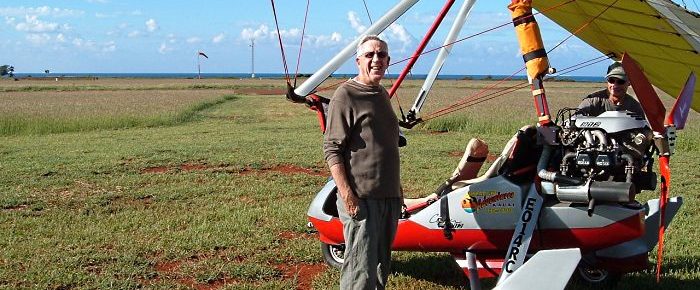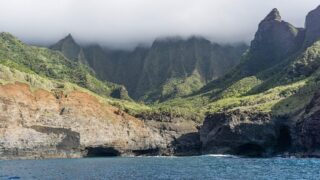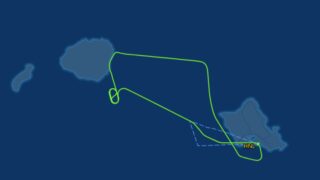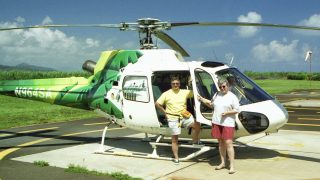We’re saddened once again this week by the deaths of two people on Kauai. The crash took place at Waiakamoo Valley near Polihale Beach. Killed were Birds of Paradise owner Gerry Charlebois, a pioneer in Hawaii ultralights, and his passenger. Charlebois was said to have over 50,000 hours of Ultralight experience.
Ultralights, like the one pictured here, are frequently seen taking off and landing at Kauai’s Port Allen air field adjacent to the south shore’s Salt Pond Beach Park. They are certainly very popular and we’ve heard from visitors and locals alike that they love the experience.
Are Ultralights Safe?
First, I’m not a pilot. Our friend, Daniel (pictured above), raved about his experience.
Here’s what others have said however.
- Research (no longer online) from Australia suggested “Ultralight fliers are about six times more likely to die for every hour flown than if they flew in general aviation aircraft.” At least 65 ultralight pilots and students died in Australia from 2001 through 2009.
- Ultralight has been compared with a motorbike in terms of crash records. Ultralights fly at slower speed than airplanes, however, which could moderate the severity of crashes.
- Professionally built Ultralights have quality design. At the same time, the craft have the least requirements in terms of training and proficiency.
- Pressure to make money shouldn’t, but could be, an issue when ultralights fly in spite of deteriorating weather conditions. We have noted that here on Kauai. The size and weight of these craft could also be an issue in terms of increased susceptibility to fast-fluctuating island wind conditions.
Prior Hawaii Ultralight crashes
May 17, 2011
- Crash took place on Kauai’s north shore following take off from Port Allen. Both the passenger and pilot died.
February 15, 2011
- Big Skies Ultralight crashed into the ocean near glass beach, just east of Port Allen Airport. The pilot, Jim Gaither, 55, and owner of Big Sky Kauai, died together with his passenger, Kim Buergel, 49, who was from Spokane Washington.
December 22, 2010
- A Big Sky Ultralight was severely damaged but no one hurt when the craft made an unplanned golf course landing in Poipu.
April 21, 2010
- An Ultralight crashed on the Big Island, after one of its wings apparently folded, killing both the pilot and passenger. It plunged into the waters off Kealakekua Bay.
August 2009
- The Birds of Paradise passenger’s leg was broken in two places, among other injuries, resulting in a federal lawsuit claiming pilot negligence and fraud. The craft plummeted into Hanapepe Valley during inclement weather. The passenger was forced to remain at the crash site overnight before he could be airlifted.
We welcome your comments.







I Was One Of The Very Early Ultralight Pilots And Worked As The Demonstration Pilot For Robertson Aircraft, Was A Dealer For The Petrodactyl And As The Marketing Director For Flyer News Paper, My Job Was To Fly Every Ner Ultralight Design And Write A Pilot Report Describing The Design.
First There Is No Such Thing As A Two Seat Ultralight. To Be A Legal Ultralight The Aircraft Must Have A Single Seat Only. There Are Several Other Requirements Which An Aircraft Must Comply With To Be A Legal Ultralight.
With The Availability Of Aircraft Mounted Ballistic Launch Parachutes, The Safety Factor For Ultralights Had Increased Dramatically. The Probability Of A Structural Failure In A Legal Ultralight Is Very Small In Any Event.
There Have Beed Chute Deployments Due To Engine Failures Over Terrain With No Available Landing Site And The Deployment Saved The Pilot.
Part Of What Makes An Ultralight An Ultralight Is The Slow Flying Speed And Very Light Weight (250 Lbs) Both Of These Basic Factors Greatly Increase The Safety Of Flight Operations In An Ultralight In Optimum Conditions.
With Proper Instruction And Good Judgement, Flying An Ultralight Can Be Your Ticket To Aviation And The Joys Of Seeing Earth From Above. All In All The Sport Of Ultralight Aviation Is Far Safer Than Ever.
After Moving To The Big Island I Took A 14 Year Hiatus From Flying And Just Last Week I Bought A Beautiful New Ultralight In Florida. I Will Being Her Back To The Big Island This Summer So I Can Get The Views Of My Home Island That I Have Been Missing. Yes The Aircraft Is Fitted With A Parachute
Ok I’ll Stop Now
As the wife of one of the unfortunate victims of the May 17, 2011 “accident” I can only say these are NOT instructional flights, there were no safety instructions prior to take off and the pilot was grossly negligent in the maintenance of his plane. This is an industry that is not monitored by the FAA or the NTSB on a regular basis due to “lack of manpower” as was explained to me by the NTSB. These planes may be safe somewhere in the world, but clearly they should not be allowed to fly on the islands. HOW MANY PEOPLE HAVE TO DIE BEFORE IT’S TOO MANY? My husband was not a thrill seeker, I purchased this tour as an anniversary gift for him to see the island from above. Had I known or seen anything posted on the internet about the crash in February 2011, I would have never purchased this for my husband. What started out as a celebration of 25 years of marriage, quickly turned into the saddest day of my life, my son, my husbands family and our friends. Spread the word–not worth the risk.
Gerry did have around 18-20,000 hours flying in trikes, god only knows how many hours he had in hang gliders. No he did not fly 8 hours a day, 5 days a week. He did accrue flight time in these for over 20 years though. May Hill, your “sound pilot” husband probably knows nothing of this category or aircraft, god forbid put a high time GA pilot in the front seat of a trike anyway. Highest rate of incidents there is in this category! One thing consistent out here I can tell you that hinders safety a lot in my opinion is the ignorant county and local officials that do not build or allow operators facilities. Would not pertain to this case, and I know that all of these were pilot error accept the golf course landing accident, but it sure would help. This as said above is not an ultralight!!! It is LSA WSC. These accidents have been very concentrated in the last 5 years. Majorly take place in HI…….?????????? Huh
First off my condolences to the families of those lost.
Thrill seekers should be well aware of the chance of dying during any of their activities. There are risks in everything we do, some more risky than others. Just because something like this is risky there is no reason to ban it or outlaw it. I imagine that the passenger that died was an adventurous sole and had done many other similiar thrill seeking adventures.
I have saw trail after trail closed on Kauai because someone went on an adventure hike, did something wrong and ended up dying or getting hurt. The families of course sued and therefore the tails were closed. Now we can no longer visit these amazing locations. I do not have the statistics in deaths and accidents for all activities on Kauai, however I imagine more people have died hiking, swimming, touring in helicopters, tour on boats, kayaking, etc… than flying in an SLSA.
My point is that while these types of activities should be regulated to require the operator to meet certain safety standards, they should not be banned or made illegal. If everything that was dangerous was banned, we would have a boring, unadventurous life.
Thanks Joe
Its usually not the aircraft but the pilot or maintenance of the aircraft in most aviation accidents. I have heard people say Gerry had 10,000 hours, then it changed within a year to 20,000 hours on trikes and now out of nowhere within 6 more months its 50,000 hours. The fact is Gerry had closer to 10000 hours and he was initially self taught on trikes during ultralight days coming from a hanggliding background. Many things and concepts that work in hanggliders do not work in trikes and hangglider pilots assume they would be better than others due to hanggliding experience but reality is not so. This is also not the first accident Gerry has had. Its public record that he even lost his CFI for 90 days due to running out of fuel with a passenger before in the FAA database. So an assumption that he is a safe pilot is anecdotal based on personal experience. NTSB’s preliminary report is out on this accident and it shows that Gerry was doing some very strange things with the fuel system in that certified aircraft which he would not be allowed to do legally. If there was a fire that started in the air, I doubt its a co-incidence. We have to respect the dead but there were two dead here, one was Gerry but one was an unsuspecting passenger. Peace.
NTSB Preliminary Report
ntsb.gov/aviationquery/brief.aspx?ev_id=20140312X35434&key=1
Statistics are funny things. Kauai visitors are statistically more likely to drown in they go in the ocean than if not. Visitors who drive cars are more likely to die or be injured in a road accident than those take buses or shuttles. As to small plane accidents like the recent Lanai incident…
Regrettably many people post on forums such as this without knowledge or experience. Man would be safer if he had never invented fire ….
I flew with Gerry many times and he was a very safe pilot with scrupulously maintained equipment. I would like to know what went wrong. Gerry brought a sense of fun and excitement into people’s lives. It is so so sad. Malama pomo borther.
First off these aircraft are not “ultralights” they haven’t been for years due to new regulations mandated be the FAA. They are Special Light Sport Aircrat (SLSA) which must follow the many of the same rules as any other general aviation aircraft ( Cessna ect.). The SLSA pilots are all required specific training by the FAA, even log book and maintence records must all be current and available at all times.
Here’s whats wrong. These pilots ( who have great skills and thousands of hours of flight time) are making a living by flying in a very difficult area. Corriosion from being near the ocean and over stressing the aircraft in high wind conditions tend to lead to premature failures on both the wing and airframe. Pilots make better tip money from their”students” by flying low and “cranking and banking” as it is exciting.
I have flown this type of aircraft about 500 hours and never experienced these failures. It is a tragic loss of life that is occuring on this island and it is preventable.
This is a very sad scene…. Strange to say it though, as my husband and I saw this Gent on “Buying Hawaii’ and he (my husband ) said right then and there that it was only a matter of time before he crashes and kills himself and/or someone else with his light weight crafts in the trade winds of Hawaii…..Not but two months later just that. There is good reason my ‘Sound Pilot’ husband does not go up in these… As for the Fed’s pouring over the craft…interesting stuff right there folks.
Too bad. And I think there was an Ultraflight crash (and death) within the past 5 years on the North Shore of O’ahu, too.
so sorry to hear about this unfortunate incident – Kauai is a beautiful place and if I had to go in that manner I could not think of any other place that I would choose to go –
in regards to the pilots experience, 8 hours a day 5 days a week for 50 weeks a year comes to 2000 hours a year – so he flew ultralights for over 25 years full time?
again, so sorry to hear about this unfortunate incident
I also can’t imagine the stated total P.I.C. hours. I CAN imagine that a simple math error occurred in the info stream, 5,000 hours does sound legit. Still, that is a substantial body of aviation knowledge.
Hi Smitty,
That was in the local news. Not sure about it either.
Aloha.
As always, we lament anyone’s untimely deaths. To address the question let’s look at aviation as a whole. It is dangerous. Wether you are in an ultralight weighing less than 250 lbs +/- (BTW, anything heaver is not an uktralight, it is a Light Sport Aircraft), or in a Boeing 747 with 350 other folks, anytime you place youself at the mercy of gravity something may go wrong and you may die.
One must ask, in any aviation mishap, were the limits of weather, pilot skill/judgement, maintenace, or flight parameters of the particular aircraft were exceeded. Most crashes are the culmination of several small steps toward disaster, either unknown or ignored. If you exceed the manufacturers specifications as published in the aircraft manual, you just became a test pilot.
Many ultralight accidents are the result of insifficient (or nonexistent) training, and a lack of full understanding of the abilities and limitations of the particular aircraft. It would seem that would not be the case here, although I question the claim of 50,000 hours. My Dad started flying in 1939, anf flew in WWII, Korea, The French-Indochina war, and our VietNam conflict. He was a Captian for Flying Tigers airline, flew fire bombers, was a civilian and USAF instructor, and owned his own plane, and he only amassed 30,000 hours as P.I.C. I myself have around 1,000 hours in a myriad of single-engine airplanes (in fact I lesrned to fly out of KOA, at the old Hawaii Country Club of the Air flying school (now there’s a story in it’s own). I have always been intriged by ultralights, but despite my stick time, and having owned three small planes, I took a course in and was certified for ultralight flight.
At least one ultralight crash (Kealakekua, Hawaii) was determined by the NTSB to have been caused by in-flight failure of a critical structural component! that was known by the pilot to have extended past it’s useful life-in-service. Hopefully, the NTSB will also be able to determine the cause of this latest tragedy.
One consistent flaunting, or at best, finessing the FAA flight rules was stated in the article ‘pressure to make money’. It is actually illegal under the Federal Aviation Regulations to fly an ultralight in commerce. Such flight is limited to flight instruction only! Some, if not all, Hawaii ultralight operations hide flightseeing under a thin veneer of ‘instruction’. To my knowledge none of these operations have provided ground instruction on the theory and practice of flight, a universal component of true flight instruction. I do know of one operation at KOA that provides Fixed Base Operations style flight training in an ultralight. Those operations are limited to the airport and defined practice areas, and not ‘flightseeing’ venues … see 2nd paragraph, above.
So to answer the question are ultralights less safe than ‘conventional’ aircraft the answer is a resounding yes … and no. Statistically yes, but when compared to misapplication of any other aircraft, not so much. Fly often, fly safely in observation of the condition of yor aircraft, the weather, and your health/attitude, or stay the hell on the ground!
Mahalo Smitty!
I’ve only flown in an ultralight once (North Shore of Oahu) and it was 10 years ago. I distinctly recall the pilot touting the safety; particularly with regard to the parachute incorporated into the structure of the aircraft. My question is: has there ever been an incident, on any of the Islands, where lives were saved by such a device…I have followed this subject fairly diligently and don’t recall ever seeing a report supporting this contention.
Hi Dodge,
I have never even heard of that. Maybe someone else knows the answer to your question.
Aloha.
I have flown with Gerry and even took my mom up with him. We had a wonderful experience and I felt that he was very clear on all safety issues when we went up.
I am very saddened to hear of the crash this week that took Gerry from us.
Us too Sandy.
Aloha
Add one more crash to the list today, and 2 more deaths in north shore kauai. These things should be outlawed.